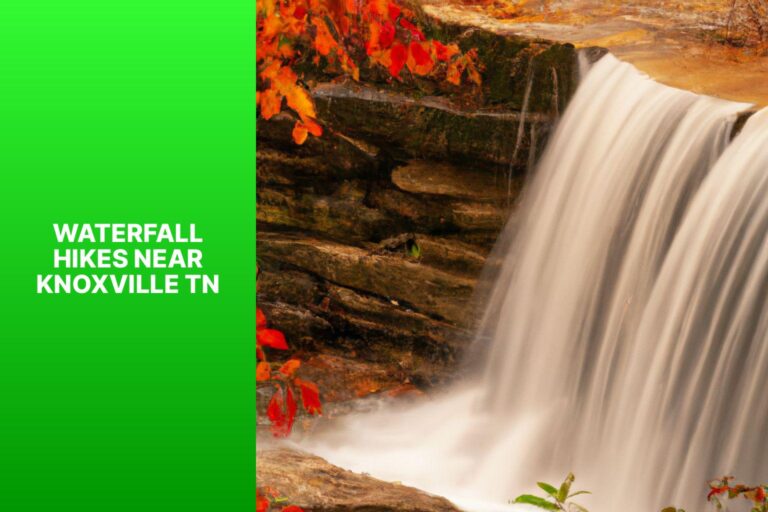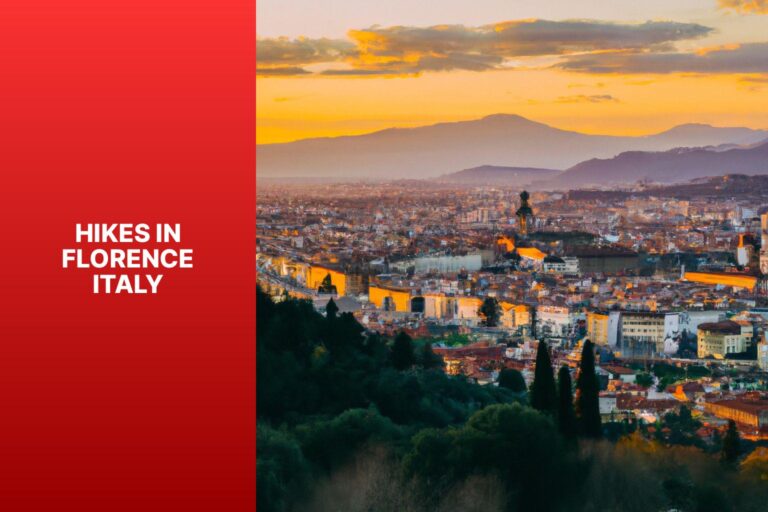How Hard is Machu Picchu Hike
Machu Picchu, the ancient Incan city nestled high in the Peruvian Andes, is one of the most iconic and renowned archaeological sites in the world. Situated amidst breathtaking mountain landscapes, Machu Picchu attracts countless visitors each year. Before embarking on a Machu Picchu hike, it is essential to understand the level of difficulty, physical and mental preparation required, and what to expect during the journey. Here is an overview of the different sections covered in this article:
What is Machu Picchu?
1. Brief History of Machu Picchu
2. Importance and Significance of Machu Picchu
What is the Machu Picchu Hike?
1. Overview of the Hiking Route
2. Different Hiking Trails to Machu Picchu
Level of Difficulty
1. Factors Affecting the Difficulty Level
2. Moderate Difficulty Hiking Routes
3. Challenging Difficulty Hiking Routes
Physical and Mental Preparation
1. Fitness and Endurance Training
2. Acclimatization to High Altitude
3. Mental Preparedness
What to Expect During the Hike?
1. Scenic Views and Landscapes
2. Climatic Conditions
3. Encounter with Wildlife
Essential Gear and Packing List
1. Clothing and Footwear
2. Camping Equipment
3. Food and Water
Guided or Independent Hike?
1. Pros and Cons of Guided Hike
2. Pros and Cons of Independent Hike
Tips for a Successful Hike
By delving into each of these sections, you will gain a comprehensive understanding of the level of difficulty associated with a Machu Picchu hike, how to prepare physically and mentally, what awaits you along the trails, essential gear to pack, and the pros and cons of choosing a guided or independent hike. With this knowledge, you can plan and undertake a successful and rewarding adventure to Machu Picchu.
Key takeaway:
- Machu Picchu Hike offers incredible scenic views and landscapes: During the hike, you can enjoy breathtaking views of the surroundings, including stunning landscapes and natural beauty.
- Machu Picchu Hike requires physical and mental preparation: The hike can be physically demanding, so it is essential to undergo fitness and endurance training. Acclimatization to high altitude and mental preparedness are crucial for a successful hike.
- Consider the pros and cons of guided and independent hikes: While a guided hike provides professional guidance and support, an independent hike offers more freedom and flexibility. Consider your preferences and needs before choosing the type of hike.
What is Machu Picchu?
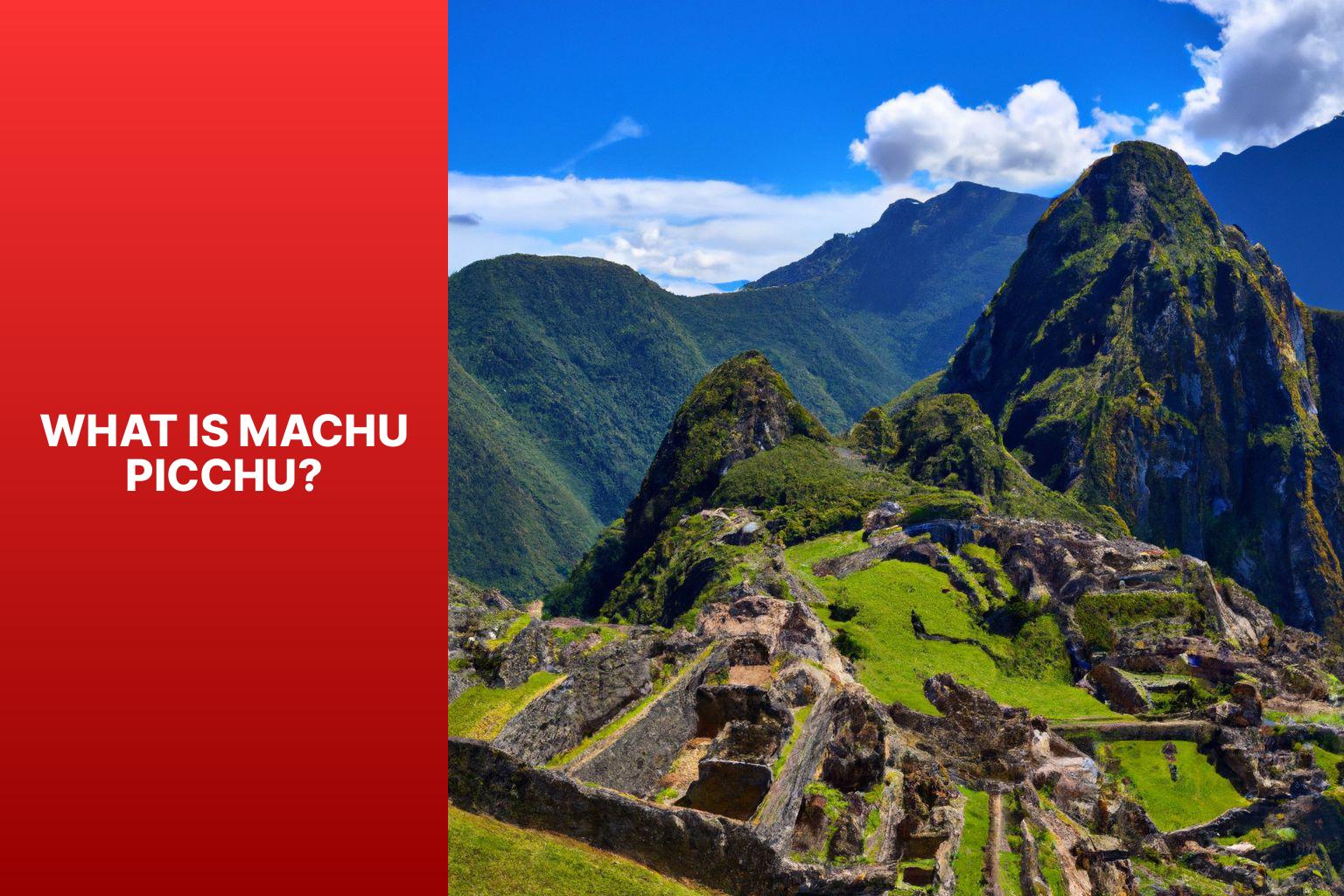
Photo Credits: Jasonexplorer.Com by Mason Rodriguez
Nestled high in the Andes Mountains, Machu Picchu is a captivating wonder that has fascinated adventurers and history buffs alike. In this section, we unveil the mystique surrounding this ancient Incan citadel. Prepare to journey back in time as we explore the brief history of Machu Picchu, uncovering the secrets of its construction and unraveling its significance. Discover why this enigmatic site continues to enthrall and attract visitors from around the globe.
Brief History of Machu Picchu
Machu Picchu, a world-renowned Inca city, was built in the mid-15th century and remains a site of fascination to this day. Hidden high in the Andes mountains, it lay undiscovered until 1911 when American explorer Hiram Bingham stumbled upon its majestic ruins.
This ancient citadel served as both a sacred sanctuary and a strategic stronghold during the peak of the Inca Empire. Many believe it was once the royal estate of the Inca ruler Pachacuti. What sets Machu Picchu apart is its impeccable stone masonry, where every stone fits together seamlessly without the need for mortar. The ingenuity and skill of the Inca civilization shine through in this remarkable architectural feat.
The purpose and function of Machu Picchu have long been debated by historians and archaeologists. Some theories propose it was a religious sanctuary, while others suggest it had military significance. Regardless, its remote location and strategic layout speak to its undeniable importance in Inca society.
Part of Machu Picchu’s allure lies in its enigmatic history. Isolated and lacking in written records, much remains unknown about its past. Yet, the site’s stunning architecture, remarkable preservation, and breathtaking mountainous backdrop continue to captivate visitors from across the globe. These qualities have earned it the prestigious titles of a UNESCO World Heritage site and one of the New Seven Wonders of the World.
In essence, the brief history of Machu Picchu serves as a testament to the brilliance of the Inca civilization. Exploring this ancient citadel not only transports us back in time but also allows us to witness the awe-inspiring legacy of a once-mighty empire.
Importance and Significance of Machu Picchu
Machu Picchu is an ancient Incan city in Peru that holds immense historical, cultural, and archaeological significance. It showcases the advanced architectural skills and ingenuity of the Incan civilization, emphasizing the importance and significance of Machu Picchu. The precision stone structures and masterfully engineered terraces, temples, and buildings highlight the immense cultural value of this site.
The city also possesses religious and ceremonial importance, evident through the dedicated temples for worship and rituals. Excavations have provided valuable insights into the lives and societal structures of the Inca people through various artifacts, pottery, tools, and even human remains.
Recognized as a UNESCO World Heritage site and one of the New Seven Wonders of the World, Machu Picchu attracts millions of visitors each year and proudly serves as a symbol of Peru’s national identity.
What is the Machu Picchu Hike?
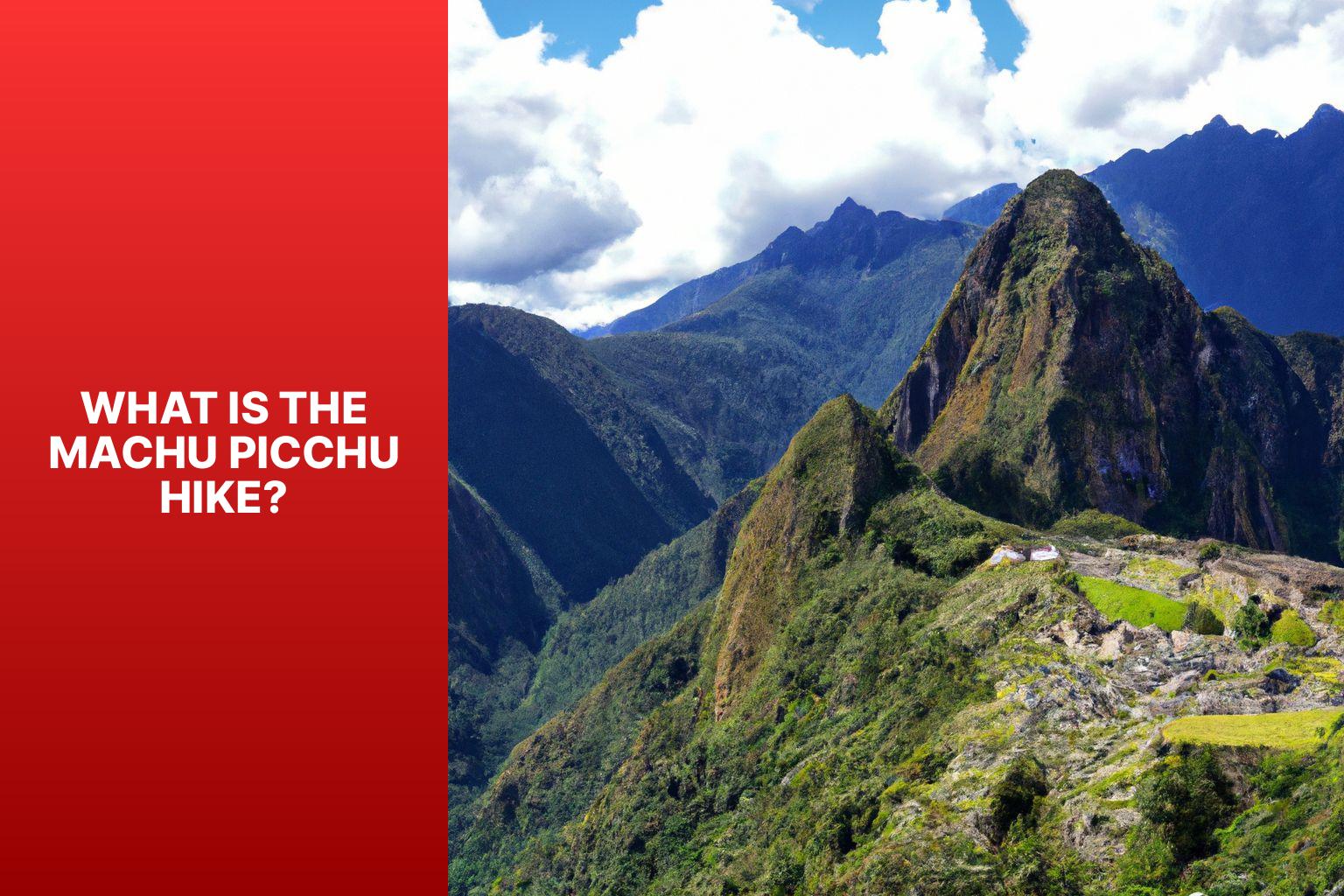
Photo Credits: Jasonexplorer.Com by Gary Nelson
Embark on an incredible adventure as we explore the breathtaking Machu Picchu Hike. Get ready to encounter the wonders of this iconic destination through our journey on the hiking trails. From an overview of the hiking route to discovering the different trails that lead to Machu Picchu, we’ll uncover the beauty and challenges that await every intrepid explorer. So lace up your boots, grab your gear, and prepare for an unforgettable trek through history and natural wonders.
Overview of the Hiking Route
The Machu Picchu hike offers an adventurous experience for hikers. Here is an overview of the hiking route:
1. Start at the Sacred Valley: The Machu Picchu hike begins at the Sacred Valley, a beautiful historical region in Peru.
2. Follow the Inca Trail: The most popular hiking route to Machu Picchu is the classic Inca Trail. This trail spans approximately 26 miles and takes about four days to complete.
3. Scenic Views and Landscapes: Along the hiking route, hikers can witness panoramic views of the Andes Mountains, lush forests, and ancient Inca ruins.
4. Ascend to Dead Woman’s Pass: One of the most challenging parts of the hike is reaching Dead Woman’s Pass, the highest point of the trail at 13,828 feet above sea level. It requires a steep ascent but offers breathtaking views.
5. Visit the Sun Gate: The hiking route ends at the Sun Gate, a historic entrance to Machu Picchu. From here, hikers are rewarded with their first glimpse of this magnificent archaeological site.
6. Explore Machu Picchu Hike: After completing the hike, hikers can spend time exploring the ancient ruins of Machu Picchu, marveling at its impressive architecture, and learning about its historical significance.
Hiking the Machu Picchu route is physically and mentally challenging. Hikers need to be well-prepared, physically fit, and mentally prepared for the altitude and strenuous terrain. It is recommended to acclimatize to the high altitude prior to the hike and engage in fitness and endurance training.
Overview of the Hiking Route
Different Hiking Trails to Machu Picchu
Different Hiking Trails to Machu Picchu
There are several hiking trails to Machu Picchu that cater to different abilities and preferences. Here are some of the trails:
- Inca Trail: The Inca Trail is famous for its stunning views of the Andes mountains and archaeological sites. It is challenging and requires a permit and a guided tour.
- Salkantay Trail: The Salkantay Trail is a rugged and challenging alternative to the Inca Trail. It offers breathtaking views of the snow-capped Salkantay Mountain.
- Lares Trail: The Lares Trail passes through traditional Andean villages, offering a mix of stunning landscapes and cultural experiences.
- Choquequirao Trek: The Choquequirao Trek is a challenging and less crowded route that leads to the equally awe-inspiring archaeological site of Choquequirao.
- Short Inca Trail: For those with limited time or physical abilities, the Short Inca Trail is a great option. It offers beautiful views and a visit to Machu Picchu.
Each trail has its own unique features, so it’s important to research and choose the one that aligns with your interests and abilities. Hiking to Machu Picchu is an unforgettable experience that allows you to immerse yourself in the breathtaking beauty of the Peruvian Andes.
Level of Difficulty
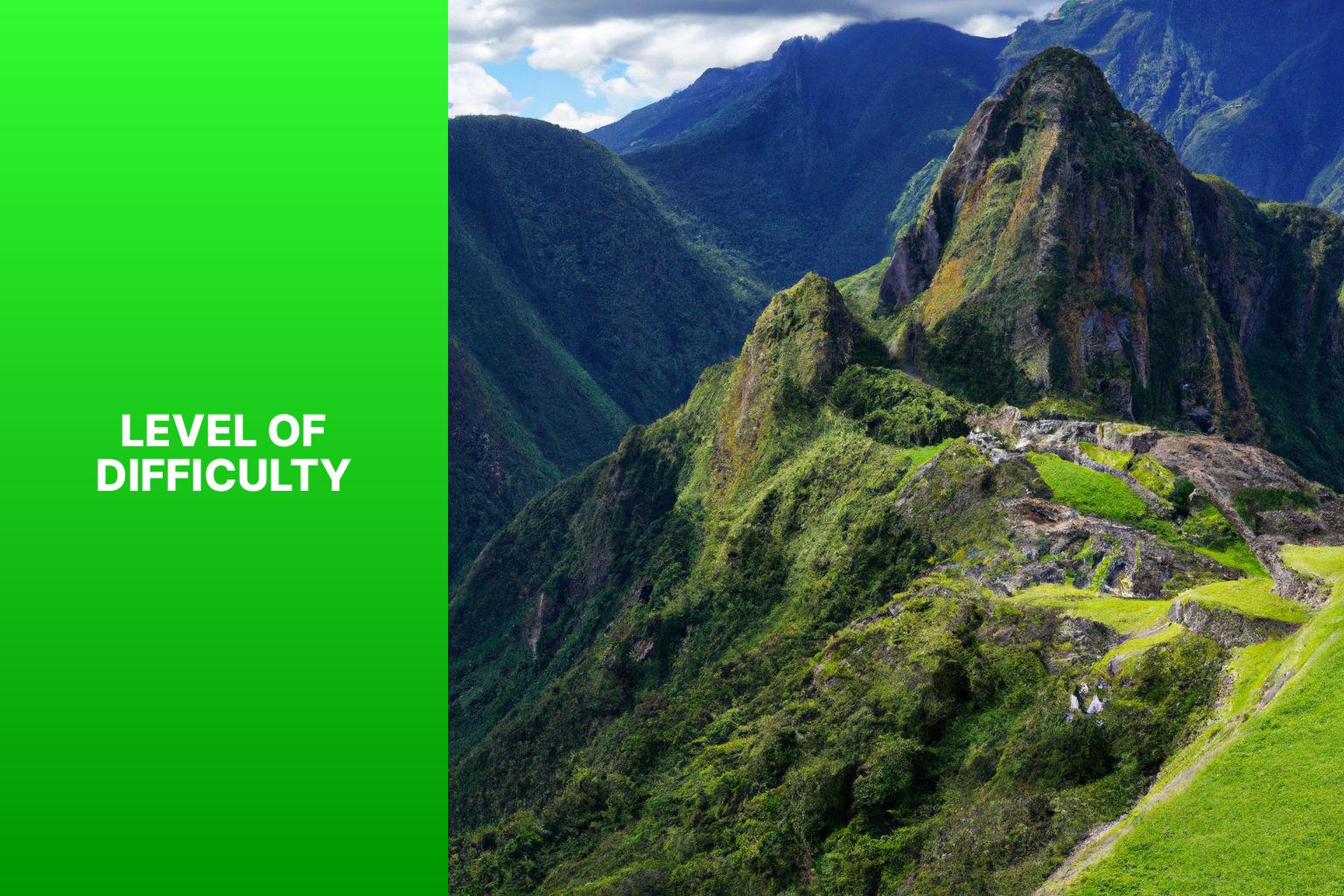
Photo Credits: Jasonexplorer.Com by Willie Martin
“
Embarking on the Machu Picchu hike? Let’s talk about the level of difficulty you can expect. From the factors influencing the hike’s challenge to moderate and challenging routes, we’ll uncover what awaits you. Get ready to brave the steep trails, challenges, and breathtaking views! Lace up your boots and let’s explore the Machu Picchu hike’s difficulty level like never before.
”
Factors Affecting the Difficulty Level
The Machu Picchu hike difficulty is influenced by several factors. These factors determine the challenge level and necessary physical and mental preparations.
Factors affecting the difficulty level include:
– Elevation: The high altitude of the Andes Mountains, where Machu Picchu is located, impacts the hike difficulty. Higher altitudes have thinner air, making breathing harder and causing altitude sickness.
– Trail length and steepness: Longer and steeper trails require more endurance and strength, making the hike more challenging.
– Weather conditions: Rain, fog, extreme temperatures, and slippery or muddy trails can increase the difficulty level.
– Physical fitness: The fitness level of the hiker plays a significant role in determining difficulty. More physically fit hikers will find the hike less challenging.
– Previous hiking experience: Hikers with prior experience are better prepared for the physical demands of the hike.
Considering these factors will help hikers determine the difficulty level they can expect during the Machu Picchu hike and make appropriate preparations for a successful experience.
Moderate Difficulty Hiking Routes
When planning your Machu Picchu hike, consider moderate difficulty routes that offer a challenging yet rewarding experience. These routes provide a good balance between physical exertion and enjoyment of the stunning surroundings.
Note that while these routes are classified as moderate difficulty, they still require a certain level of physical fitness and acclimatization to the high altitude. It’s recommended to engage in fitness and endurance training prior to your hike and gradually increase your stamina. Also, listen to your body and take breaks when needed to prevent overexertion.
Challenging Difficulty Hiking Routes
- The Salkantay Trek is one of the most challenging hiking routes to Machu Picchu. It takes 4 to 5 days to complete and reaches an altitude of 4,600 meters at its highest point.
- The Choquequirao Trek is another challenging route that takes 8 to 10 days to complete. It offers stunning views of the surrounding mountains and valleys, but it requires a high level of fitness and endurance.
- The Vilcabamba Trek is a lesser-known but equally challenging route to Machu Picchu. It takes 6 to 7 days to complete and involves steep ascents and descents, as well as remote and rugged landscapes.
- The Ausangate Trek is known for its challenging terrain and high altitude. This 6 to 7-day trek takes hikers around the Ausangate Mountain, reaching altitudes of up to 5,200 meters.
- The Lares Trek is a challenging alternative to the classic Inca Trail. It takes 3 to 4 days to complete and offers a unique opportunity to interact with local Andean communities while hiking through breathtaking landscapes.
When considering these challenging hiking routes, it is important to be physically and mentally well-prepared. Regular fitness and endurance training are essential to tackle the steep ascents and high altitudes. Acclimatization to the high altitude is crucial to avoid altitude sickness. Mental preparedness, determination, and a positive mindset are necessary to overcome the challenges of these demanding hikes. Always hike with a knowledgeable guide or in a group for safety reasons.
Physical and Mental Preparation
Get ready to conquer the majestic Machu Picchu hike! In this section, we’ll delve into the essential aspects of physical and mental preparation. We’ll uncover the secrets of fitness and endurance training, ensuring you’re ready to tackle the challenging terrains. We’ll discuss the importance of acclimatization to high altitudes, helping you combat potential altitude sickness. We’ll touch upon the crucial role of mental preparedness, equipping you with the mindset needed to overcome any obstacles along the way. So, let’s gear up and get ready for an unforgettable adventure!
Fitness and Endurance Training
To prepare for the Machu Picchu hike, it is important to focus on fitness and endurance training. Here are some key aspects to consider:
- To improve cardiovascular fitness, engage in activities such as running, cycling, or swimming. Aim to spend at least 30 minutes, three to five times a week, engaging in moderate to intense aerobic exercise.
- Incorporate strength training exercises into your routine to enhance muscle endurance and overall body strength. Concentrate on leg-focused exercises like squats, lunges, and step-ups to navigate the challenging terrain.
- Include climbing stairs in your training to prepare for the uphill sections of the hike. Gradually increase the number of flights or repetitions as your fitness level improves.
- Plan regular endurance hikes that gradually increase in distance and difficulty. This will simulate the demands of the Machu Picchu trek. Increase the intensity and duration of these hikes over time.
- Give your body time to acclimatize to high altitudes in order to lower the risk of altitude sickness. Prior to the hike, spend a few days in Cusco or other high-altitude locations.
- Mentally prepare yourself to stay positive and motivated during challenging moments of the hike. Visualize successfully completing the journey and overcoming any mental barriers.
With a well-rounded fitness and endurance training program, you will be fully prepared for the Machu Picchu hike. This will enable you to truly enjoy the breathtaking scenery and achieve your hiking goals.
Acclimatization to High Altitude
Acclimatization to high altitude is absolutely vital for the Machu Picchu hike. To properly acclimatize, it is crucial to follow these steps:
- Gradual ascent: The key is to gradually increase elevation over several days before reaching high altitude areas. This allows your body to adjust naturally to the decrease in oxygen levels.
- Stay hydrated: It is important to drink ample amounts of water in order to prevent dehydration, which can worsen altitude sickness. Aim to consume at least 3-4 liters of water per day.
- Opt for light, nutritious meals: Consuming small, frequent meals that are high in carbohydrates will provide you with necessary energy while reducing strain on your digestive system at high altitudes.
- Avoid alcohol and caffeine: These substances can contribute to dehydration and exacerbate altitude sickness symptoms. It is highly recommended to limit or completely refrain from consuming them during the acclimatization process.
- Take it easy: Once you have reached high altitude, it is essential to take things slow and listen to your body. Avoid engaging in strenuous activities for the first few days, allowing ample time for adjustment.
- Consider medication: Consulting a healthcare professional about using medication such as acetazolamide can be beneficial in preventing or alleviating altitude sickness symptoms.
By prioritizing proper acclimatization to high altitude, you will ensure a safe and pleasurable Machu Picchu hike. Follow these steps diligently to minimize the risk of altitude sickness and fully immerse yourself in the awe-inspiring beauty of this remarkable destination.
Mental Preparedness
Mental preparedness is crucial for the Machu Picchu hike. The challenging nature requires strong mental preparedness to overcome obstacles. Here are some important factors to consider for mental preparedness:
- Stay positive: Maintaining a positive mindset will significantly help you navigate tough moments during the hike. It is important to remind yourself of the incredible experience and sense of accomplishment you will have at Machu Picchu.
- Mental endurance: Training your mind to handle long hours of hiking is crucial. Visualize yourself successfully completing the hike and focus on positive thoughts. This will help you build mental endurance and stay strong throughout the journey.
- Set realistic expectations: It’s important to understand that the hike will be physically demanding and mentally challenging. Setting realistic goals for yourself will help you avoid feeling overwhelmed and give you a better chance at successfully completing the hike.
- Embrace perseverance: There may be times during the hike when you feel tired or discouraged. It is important to embrace perseverance and remind yourself that you have the strength and determination to push through any difficulties that may come your way.
- Practice mindfulness: Taking moments to be present and appreciate the beauty of your surroundings can greatly contribute to your mental preparedness. Engaging your senses and cultivating mental clarity will help you stay focused and motivated throughout the hike.
Remember, mental preparedness is just as important as physical preparedness for a successful Machu Picchu hike. Stay focused, positive, and determined to conquer any challenges that may arise.
Fact: Mental preparedness is key for any strenuous activity. Training your mind enhances performance and enjoyment.
What to Expect During the Hike?
Get ready for an unforgettable adventure as we dive into what to expect during the Machu Picchu hike. From breathtaking scenic views and landscapes to navigating through the unpredictable climatic conditions, this section will provide you with an insider’s guide to the incredible journey. And if that’s not enough, be prepared for some thrilling encounters with the local wildlife along the way. Lace up your hiking boots and let’s explore the wonders that await you on this epic trek.
Scenic Views and Landscapes
The Machu Picchu hike offers breathtaking scenic views and diverse landscapes. As you trek through challenging routes, you will be rewarded with awe-inspiring sights that showcase the region’s beauty.
The hike takes you through the majestic Andes Mountains, allowing you to witness natural wonders. The Sacred Valley offers stunning vistas with terraced fields and meandering rivers. High mountain passes provide panoramic views and a sense of accomplishment.
Diverse ecosystems, including cloud forests with vibrant flora and fauna, await you along the trails. Vibrant colors of orchids, bromeliads, and other exotic plants will leave you in awe. Look out for hummingbirds and butterflies fluttering around, adding beauty to the scenery.
The changing landscapes throughout the hike provide a unique experience. From rugged mountain trails to serene valleys, each step offers a new perspective. The contrast between the ancient ruins of Machu Picchu and the untouched natural surroundings enhances the sense of wonder and appreciation for this UNESCO World Heritage Site.
Immerse yourself in the scenic views and landscapes of Machu Picchu and let its beauty captivate your senses. It is an unforgettable journey combining physical challenges with unparalleled natural beauty, leaving you with lasting memories.
Climatic Conditions
Climatic conditions play a crucial role in the Machu Picchu hike, and it’s essential to be well-prepared for the ever-changing weather. Throughout the year, the region experiences a wide spectrum of climatic conditions.
1. Temperature: In the Machu Picchu region, temperatures can considerably vary. During the dry season (May to September), the daytime temperatures can soar as high as 25 C (77 F) and drop to around 5 C (41 F) at night. In the wet season (November to March), the temperatures are slightly milder, ranging from 15 C to 20 C (59 F to 68 F) during the day and around 10 C (50 F) at night.
2. Rainfall: The wet season brings abundant rainfall to the region, so hikers should come prepared for frequent rain showers. It’s crucial to have proper rain gear such as waterproof jackets, pants, and backpack covers in order to stay dry and comfortable. It is advised to pack extra layers of clothing to be ready in case of rainfall.
3. Altitude: Machu Picchu is located at a high altitude, and hikers may experience altitude sickness. It is important to acclimatize properly by spending a few days in Cusco or other high-altitude areas before embarking on the hike. Symptoms of altitude sickness include headache, nausea, fatigue, and shortness of breath.
4. Sun Exposure: Due to the high altitude and its proximity to the equator, the Machu Picchu region is susceptible to intense sunlight. To protect against sunburn and heat exhaustion, it is necessary to use sunscreen, wear hats, sunglasses, and opt for lightweight, breathable clothing.
5. Microclimates: The Machu Picchu region is home to various microclimates, resulting in significant variations in weather conditions across different areas. Hikers should be prepared for sudden changes in temperature and weather conditions during the hike.
Fact: The Machu Picchu hike offers breathtaking views of the Andean mountain range, flourishing rainforests, and ancient Inca ruins. This challenging yet rewarding trek provides an extraordinary experience for outdoor enthusiasts and history buffs alike.
Encounter with Wildlife
During the Machu Picchu hike, you will have an extraordinary encounter with wildlife. The diverse ecosystem of the region serves as a natural habitat for a variety of animals, which adds to the uniqueness of the hike.
As you explore the landscapes, make sure to keep an eye out for the native wildlife. Along the hiking trails, you may come across Andean condors, llamas, alpacas, and vicu as. These animals freely roam in their natural environment, showcasing the abundant biodiversity of the area.
While encountering wildlife is both thrilling and memorable, it is important to remember to observe them from a distance. Avoid approaching or feeding the animals, as it is crucial to prioritize the safety of both yourself and the wildlife.
Encountering wildlife during the Machu Picchu hike not only adds to the adventure but also allows you to connect with the natural wonders of the region. Remember to have your cameras ready to capture these incredible moments and create lasting memories of your journey through this awe-inspiring landscape.
Essential Gear and Packing List
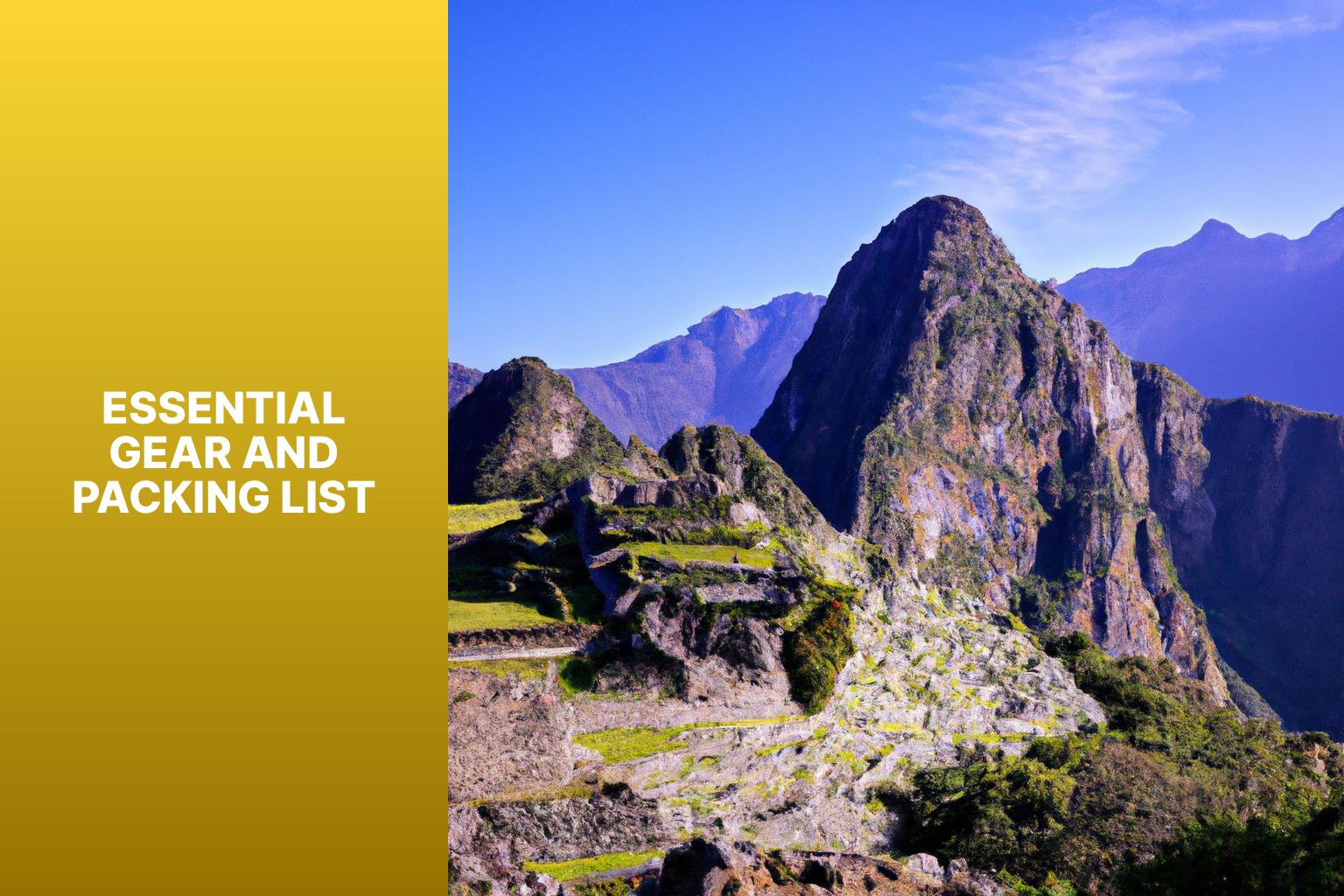
Photo Credits: Jasonexplorer.Com by Noah Williams
When it comes to conquering the Machu Picchu hike, being prepared with the right gear and packing essentials is absolutely crucial. In this section, we’ll dive into the must-have items that will make your journey a success. From clothing and footwear to camping equipment and provisions like food and water, we’ll cover all the essentials you need to tackle this awe-inspiring adventure. So get ready to gear up and pack smart for your Machu Picchu hike!
Clothing and Footwear
When preparing for the Machu Picchu hike, carefully consider your clothing and footwear choices. The right gear can impact your comfort and safety. Essential items to pack include:
- Hiking Shoes: Invest in sturdy hiking boots or trail shoes with ankle support and traction. Make sure they are broken-in before the hike.
- Moisture-Wicking Clothing: Opt for breathable and quick-drying materials like nylon or polyester. Pack lightweight moisture-wicking shirts, pants, and underwear.
- Layering System: Pack clothing that can be easily layered for changing weather conditions. Include a lightweight base layer, insulating mid-layer, and a waterproof and windproof outer shell.
- Hat and Sunglasses: Wear a wide-brimmed hat and sunglasses with UV protection to shield yourself from the sun’s rays.
- Lightweight Rain Gear: Pack a compact, waterproof jacket and pants to stay dry in case of rain.
- Socks: Bring several pairs of moisture-wicking and cushioned hiking socks to prevent blisters and keep your feet comfortable.
- Gloves and Warm Hat: Pack lightweight gloves and a warm hat for colder temperatures at higher altitudes.
Remember to pack clothing and footwear based on expected climate conditions and hike duration. Prioritize comfort, breathability, and functionality in your gear choices.
Try out your clothing and footwear before the hike to ensure proper fit and comfort. This will prevent discomfort or issues during the challenging trek to Machu Picchu. With the right clothing and footwear, you’ll be well-prepared to enjoy the magnificent landscapes and breathtaking views along the way.
Camping Equipment
When preparing for the Machu Picchu hike, it is crucial to have the appropriate camping equipment for a comfortable and safe journey. Here is a list of essential camping equipment to consider:
1. Tent: A lightweight and durable tent is necessary for shelter. Look for a tent that is easy to set up and provides enough space for you and your belongings.
2. Sleeping Bag: Choose a sleeping bag suitable for the weather conditions. Look for one with a low temperature rating to keep you warm at night.
3. Sleeping Pad: A sleeping pad provides insulation and cushioning for a comfortable sleep. Opt for a lightweight and compact one.
4. Camp Stove: A portable camp stove is essential for cooking and boiling water. Look for one that is lightweight and fuel-efficient.
5. Cookware: Pack lightweight and durable cookware such as a pot, pan, and utensils for preparing meals.
6. Headlamp: A headlamp is crucial for navigating in the dark. Choose one with a long battery life and adjustable brightness.
7. Water Filter: Having a lightweight and effective water filter is essential for obtaining safe drinking water.
8. Backpack: Choose a spacious backpack with comfortable straps and multiple compartments.
9. First Aid Kit: Always carry a well-stocked kit with essential items like bandages, antiseptic wipes, pain relievers, and blister treatment.
10. Navigation Tools: Bring a map, compass, and GPS device to stay on the designated hiking trails.
Having the right camping equipment will enhance your experience and ensure you are prepared for the challenges of the Machu Picchu hike.
Food and Water
When hiking to Machu Picchu, it is important to consider the food and water you will need.
- Stay hydrated: Drink 2-3 liters of water per day to prevent altitude sickness.
- Treat water sources: Use a reliable water filter or treat natural springs and streams before drinking.
- Pack lightweight, high-energy meals: Bring granola bars, nuts, dried fruits, and energy gels for essential nutrients and energy throughout the hike.
- Meal services on the trail: Some hiking companies provide hot breakfasts, lunches, and dinners to fuel you in challenging conditions.
- Accommodate dietary restrictions: Inform your hiking company or pack suitable food options if you have dietary restrictions or allergies.
Machu Picchu, an ancient Inca citadel in Peru’s Andes Mountains, was built in the 15th century and rediscovered in 1911. It is a remarkable example of Incan engineering and architecture and served as a royal estate and an important religious and administrative center. Today, it is a UNESCO World Heritage site and a popular destination for millions of visitors to appreciate its beauty and learn about the Inca civilization.
Guided or Independent Hike?
Deciding whether to go on a guided or independent hike to Machu Picchu? Let’s weigh the options and discover the pros and cons of each. From experiencing the expertise and convenience of a guided hike to the freedom and flexibility of an independent trek, we’ll explore what each option has to offer. Get ready to lace up your hiking boots and uncover the best approach for your Machu Picchu adventure!
Pros and Cons of Guided Hike
The pros and cons of a guided hike to Machu Picchu can help you decide whether to choose a guided tour or go independently.
Pros of a guided hike:
- Expert guidance: Experienced guides provide expertise and knowledge about Machu Picchu’s history, culture, and significance.
- Safety and security: Guides ensure your safety in high-altitude environments and handle emergencies.
- Convenience and logistics: Guided tours take care of transportation, accommodations, permits, and entrance fees.
- Cultural immersion: Guides enhance your experience by sharing stories, legends, and local perspectives.
Cons of a guided hike:
- Lack of flexibility: Guided hikes follow a set itinerary, limiting your ability to explore at your own pace.
- Group dynamics: Adjusting to the preferences and abilities of other participants can impact the pace and experience.
- Cost: Guided hikes are more expensive compared to going independently.
- Less solitude: Being part of a guided group means sharing the experience with other hikers.
Ultimately, the choice between a guided hike and an independent hike to Machu Picchu depends on your personal preferences, budget, and the level of convenience and assistance you desire throughout the journey.
Pros and Cons of Independent Hike
The benefits and drawbacks of embarking on an independent hike to Machu Picchu are as follows:
Pros:
– Flexibility: Opting for an independent hike gives you the advantage of setting your own pace, taking breaks at scenic viewpoints without time restrictions, and modifying your itinerary according to your preferences. – Cost savings: Independent hikes tend to be more budget-friendly compared to guided tours. You have greater control over your expenses and can opt for affordable accommodations, transportation, and meals. – Personal growth: By hiking to Machu Picchu independently, you open yourself up to a personal and introspective adventure that encourages self-discovery and self-reliance.
Cons:
– Lack of guidance: The absence of a knowledgeable guide during an independent hike means you miss out on historical and cultural insights about the route and Machu Picchu. – Navigation challenges: Without a guide, finding the correct routes and navigating the trails can be difficult, especially for inexperienced hikers or those unfamiliar with the area. – Safety concerns: Independent hiking requires thorough planning, preparation, and awareness of potential risks and safety measures. Without a guide, you assume the responsibility of ensuring your own safety.
When considering these advantages and disadvantages, it is crucial to assess your preferences, skills, and comfort level before deciding on an independent hike to Machu Picchu. Conduct thorough research on the hiking trails, acquire a detailed map and navigation tools, and be mentally and physically prepared for the challenges that come with independent hiking.
Tips for a Successful Hike
When embarking on a hike to Machu Picchu, it’s important to follow these useful tips for a successful and enjoyable experience:
1. Prioritize your physical preparation: make sure to focus on your fitness level by regularly engaging in cardiovascular and strength training exercises. This will enhance your endurance and minimize the impact of the challenging terrain.
2. Acclimatize to the high altitude: take the time to spend a few days in high-altitude areas to allow your body to adjust to the thinner air. This will reduce the risk of altitude sickness and enable you to fully enjoy the hike.
3. Pack wisely: it is essential to bring the necessary items such as a sturdy backpack, comfortable hiking boots, appropriate clothing, a waterproof jacket, sunscreen, a hat, insect repellent, and an ample supply of water. Don’t forget to pack some snacks and a camera to capture the breathtaking views!
4. Choose a well-planned itinerary: it is crucial to research and select a reputable tour operator that offers a well-structured itinerary. This will ensure that you have enough time to acclimate to the altitude, savor the beautiful scenery, and explore Machu Picchu without feeling rushed.
5. Stay hydrated and nourished: drink plenty of water to avoid dehydration and bring energy-rich snacks to maintain your stamina. It is important to listen to your body’s needs and refuel as necessary.
6. Take breaks: pace yourself and rest whenever needed. By doing so, you will prevent exhaustion and be able to fully appreciate the stunning surroundings.
7. Respect the environment: be mindful of your impact on Machu Picchu, a UNESCO World Heritage site. Stick to designated trails, dispose of waste properly, and refrain from touching or removing any artifacts.
Fun Fact: Machu Picchu attracts approximately 1.5 million visitors each year, solidifying its position as one of the most popular tourist destinations in South America.
Frequently Asked Questions
How hard is the Machu Picchu hike?
The Machu Picchu hike is considered a moderate level hike, covering 26 miles over four days with a maximum elevation of 13,828 feet. It is challenging but manageable with proper fitness preparation.
Are there rest camps along the Machu Picchu hike?
Yes, there are rest camps along the Machu Picchu hike where you can take breaks. Some outfitters also provide portable ‘porta potties’ for better sanitation.
What should I pack for the Machu Picchu hike?
When packing for the Machu Picchu hike, it is important to pack light. Bring layers of clothing, including thermal base layers, a rain jacket, and a sunhat. Pack well-broken-in walking boots for the hike and flip flops or light sandals for the evenings.
Is the Machu Picchu hike a technical trek?
No, the Machu Picchu hike is not considered a technical trek and does not require special skills or equipment. It does involve steep inclines, uneven ground, and rough cobbly bits.
Can I hike the Machu Picchu trail solo?
No, hiking the Machu Picchu trail solo is not allowed. It is required to have a guide with you, as mandated by the government of Peru.
Is the Machu Picchu hike worth it?
Absolutely! The Machu Picchu hike offers breathtaking views, awe-inspiring terrain, and the chance to explore historic sights. It is considered one of the greatest adventure experiences and provides unforgettable memories.




